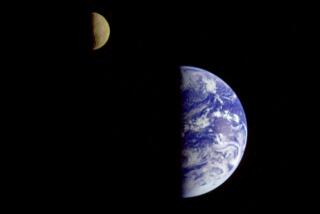Found: A never-before-seen asteroid with six comet-like tails
A bizarre, never-before-seen asteroid with six comet-like tails has been found in the asteroid belt between Mars and Jupiter, and scientists are shocked.
“I’m trying not to use the word ‘freak,’” said David Jewitt of UCLA and lead author of a paper about the six-tailed asteroid, “but that’s what it is. It is definitely freakish.”
A NASA release described the asteroid as looking like “a rotating lawn sprinkler” with dust radiating out from it like spokes on a wheel.
PHOTOS: Amazing images from space
What makes this find especially weird is that asteroids almost never have any kind of tail at all.
Those dramatic blue tails we see in images from space are generally associated with comets -- “dirty snowballs” that originate in the outer regions of our solar system. The tail forms when the comet’s orbit takes it close enough to the sun that the ice in its nucleus melts, releasing dust and gas that trail behind it.
But asteroids, also known as space rocks, generally originate in the asteroid belt where it is mostly too hot for ice to survive. When they zoom through space, they look like small, moving points of light.
“This thing should just be a rock,” said Jewitt of the six-tailed asteroid. “Imagine if you went in your backyard and a rock suddenly started spouting this stuff off.”
So, what’s going on here? No one is totally sure. A computer model by Jessica Agarwal of the Max Planck Institute in Germany suggests that the six tails could have formed by separate dust ejection events that occurred at irregular intervals on April 15, July 18, July 24, Aug. 8, Aug. 26 and Sept. 4 of this year.
But that doesn’t explain what is causing those random ejections of dust. For now, Jewitt’s best guess is that radiation pressure from the sun has caused the asteroid’s spin rate to speed up. If it is spinning fast enough, the asteroid could start to fall apart. Perhaps these ejections are like little avalanches of dust falling off the asteroid’s surface before the thing finally breaks up entirely.
PHOTOS: Comet ISON journeys through the solar system
But don’t take Jewitt’s word for it. “I am open to the possibility that this explanation is completely wrong,” he said. “It is possible that there is an explanation we haven’t thought of yet, and that might be even more interesting.”
The asteroid itself is about 1,400 feet wide, and it’s located on the near side of the asteroid belt between Mars and Jupiter, about twice the distance from the sun as the Earth. It was first discovered in August of 2013, when scientists using the Pan-STARRS telescope in Hawaii noticed what looked like a fuzzy asteroid. The Hubble Space Telescope took a closer look at the asteroid on Sept. 10, revealing its showy tails. Hubble took another image of it on Sept. 23.
If Jewitt’s working theory is correct, the six-tailed asteroid may break up soon -- whatever that means for an asteroid that’s been around since the solar system formed.
“Do I think it will happen? Yes,” said Jewitt. “But I don’t think it will break up tomorrow. It’s been around for more than 1 billion years; what’s another 100,000 years to this little guy?”
Look for more views of the asteroid, known as P/2013 P5, in the photo gallery above. A paper describing the comet was published in the Nov. 7 issue of Astrophysical Journal Letters.
If six-tailed asteroids make you giddy, then you should definitely follow me on Twitter.
ALSO:
No ‘island’ of tsunami debris floating toward U.S., NOAA says
Chelyabinsk meteor: More asteroids likely to hit Earth, research says
Chelyabinsk asteroid smashed glass, burned skin, defied expectations







